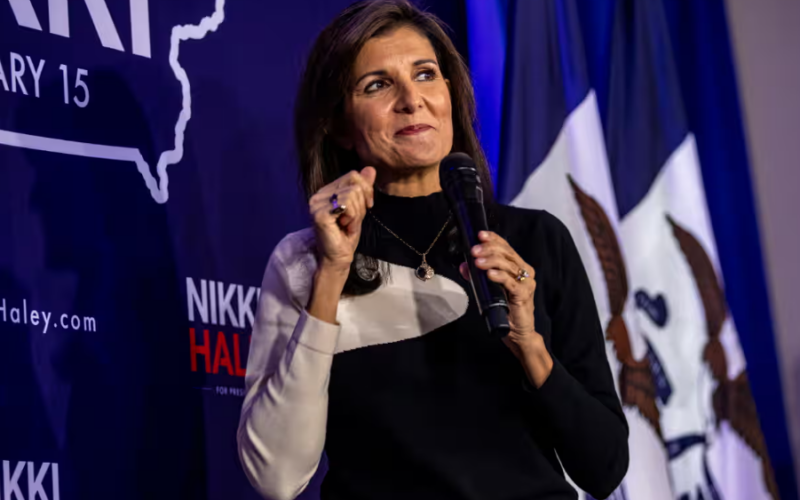In a bid to secure a political edge and position herself as a formidable contender in the political arena, Nikki Haley is strategically working to broaden her coalition swiftly, aiming to surpass the influence of former President Donald Trump. Haley’s political maneuvers indicate a calculated approach to navigate the complexities of the Republican landscape and build a diverse coalition of supporters in her quest for political prominence.
The political landscape within the Republican Party has undergone significant shifts since the tenure of Donald Trump. As prominent figures within the party vie for influence and positioning, Nikki Haley has emerged as a key player employing a deliberate strategy to outmaneuver Trump and expand her coalition rapidly.
From a journalistic standpoint, the coverage of Haley’s efforts to broaden her coalition presents an opportunity to analyze the dynamics within the Republican Party and the strategies employed by political figures seeking to navigate the post-Trump era. Interviews with political analysts, party insiders, and representatives from Haley’s camp can offer valuable insights into the motivations behind this political maneuvering.
Haley’s endeavor to expand her coalition swiftly suggests a recognition of the diverse voices and factions within the Republican Party. The party, marked by a range of ideologies and allegiances, requires a nuanced approach to build a broad base of support. Haley’s strategy is indicative of a concerted effort to appeal to various segments of the party, from staunch Trump loyalists to more centrist Republicans.
The former South Carolina governor and U.S. ambassador to the United Nations is strategically positioning herself as a unifying force within the Republican Party. The challenges of navigating the ideological spectrum and addressing the divergent views within the party necessitate a careful balancing act, and Haley’s ability to expand her coalition rapidly is contingent on her adept navigation of these dynamics.
Haley’s political calculations also reflect an understanding of the influence that Trump still wields within the Republican base. As a high-profile figure with a significant following, Trump’s endorsement can be a game-changer in Republican primaries and elections. Haley’s efforts to broaden her coalition may include measures to bridge the gap between Trump loyalists and those seeking a more moderate and inclusive approach.
The timing of Haley’s strategic moves is crucial, considering the upcoming electoral cycles and the potential for key political events that could shape the trajectory of the Republican Party. As the party grapples with its identity in the post-Trump era, Haley’s rapid coalition-building efforts position her as a central figure capable of navigating the evolving landscape.
The expansion of Haley’s coalition also prompts questions about the specific policy positions, messaging strategies, and outreach efforts that underpin her political approach. Analyzing the substance of Haley’s engagement with diverse segments of the Republican Party provides a deeper understanding of the nuances within her political strategy.
In conclusion, Nikki Haley’s strategic efforts to expand her coalition rapidly within the Republican Party underscore the complexities of post-Trump politics. The maneuvering within the party, marked by diverse ideological currents, requires a nuanced approach, and Haley’s calculated efforts indicate a keen awareness of the challenges and opportunities within the evolving political landscape. As she seeks to outmaneuver Trump and solidify her position as a leading Republican figure, the dynamics of coalition-building and the delicate balance of navigating intra-party dynamics will play a pivotal role in shaping Haley’s political trajectory.
Nikki Haley’s strategic maneuvers: expanding coalition rapidly in effort to outmaneuver Trump
In a bid to secure a political edge and position herself as a formidable contender in the political arena, Nikki Haley is strategically working to broaden her coalition swiftly, aiming to surpass the influence of former President Donald Trump. Haley’s political maneuvers indicate a calculated approach to navigate the complexities of the Republican landscape and build a diverse coalition of supporters in her quest for political prominence.
The political landscape within the Republican Party has undergone significant shifts since the tenure of Donald Trump. As prominent figures within the party vie for influence and positioning, Nikki Haley has emerged as a key player employing a deliberate strategy to outmaneuver Trump and expand her coalition rapidly.
From a journalistic standpoint, the coverage of Haley’s efforts to broaden her coalition presents an opportunity to analyze the dynamics within the Republican Party and the strategies employed by political figures seeking to navigate the post-Trump era. Interviews with political analysts, party insiders, and representatives from Haley’s camp can offer valuable insights into the motivations behind this political maneuvering.
Haley’s endeavor to expand her coalition swiftly suggests a recognition of the diverse voices and factions within the Republican Party. The party, marked by a range of ideologies and allegiances, requires a nuanced approach to build a broad base of support. Haley’s strategy is indicative of a concerted effort to appeal to various segments of the party, from staunch Trump loyalists to more centrist Republicans.
The former South Carolina governor and U.S. ambassador to the United Nations is strategically positioning herself as a unifying force within the Republican Party. The challenges of navigating the ideological spectrum and addressing the divergent views within the party necessitate a careful balancing act, and Haley’s ability to expand her coalition rapidly is contingent on her adept navigation of these dynamics.
Haley’s political calculations also reflect an understanding of the influence that Trump still wields within the Republican base. As a high-profile figure with a significant following, Trump’s endorsement can be a game-changer in Republican primaries and elections. Haley’s efforts to broaden her coalition may include measures to bridge the gap between Trump loyalists and those seeking a more moderate and inclusive approach.
The timing of Haley’s strategic moves is crucial, considering the upcoming electoral cycles and the potential for key political events that could shape the trajectory of the Republican Party. As the party grapples with its identity in the post-Trump era, Haley’s rapid coalition-building efforts position her as a central figure capable of navigating the evolving landscape.
The expansion of Haley’s coalition also prompts questions about the specific policy positions, messaging strategies, and outreach efforts that underpin her political approach. Analyzing the substance of Haley’s engagement with diverse segments of the Republican Party provides a deeper understanding of the nuances within her political strategy.
In conclusion, Nikki Haley’s strategic efforts to expand her coalition rapidly within the Republican Party underscore the complexities of post-Trump politics. The maneuvering within the party, marked by diverse ideological currents, requires a nuanced approach, and Haley’s calculated efforts indicate a keen awareness of the challenges and opportunities within the evolving political landscape. As she seeks to outmaneuver Trump and solidify her position as a leading Republican figure, the dynamics of coalition-building and the delicate balance of navigating intra-party dynamics will play a pivotal role in shaping Haley’s political trajectory.








